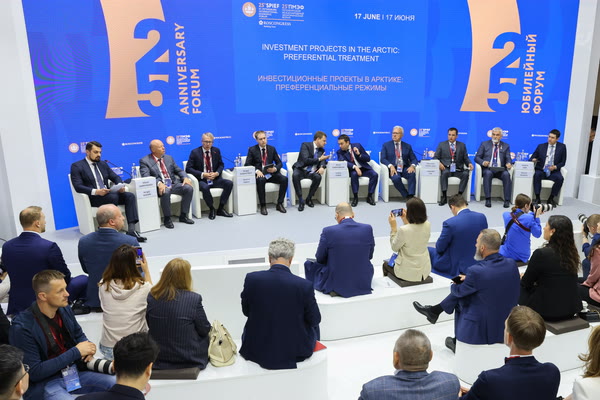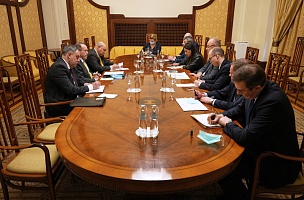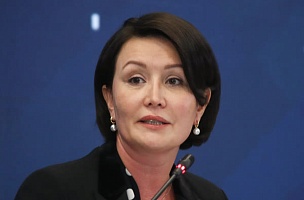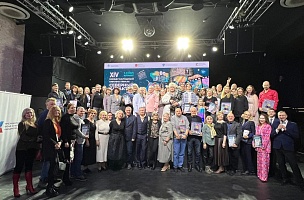The Far East has contributed to economic growth in the Arctic
“The Arctic is somewhat indebted to the Far East. At the beginning, a number of new conditions were created under the Far East’s system of governance. Many of these were unprecedented for Russia. <...> A number of historic decisions were taken to establish advanced special economic zones and the Free Port [of Vladivostok – ed.], level out energy tariffs, and introduce the Far Eastern Mortgage programme. When this system was extended to cover the Russian Arctic, even more dynamic regimes were put in place. These included the world’s largest free economic zone in the Arctic, and a reduction in the administrative burden,” Alexei Chekunkov, Minister for the Development of the Russian Far East and Arctic.
“The actions taken by the government in the Arctic – from regional to federal authorities – are a striking example of effective public-private partnership. That’s because they have had a tangible effect on new projects, construction sites, jobs, and prospects opening up for people living in the North,” Andrey Chibis, Governor of Murmansk Region.
Russia’s resources are allowing advances to be made in the Arctic
“Many people pitied the Russian Federation for its ‘resource curse’: its reliance on oil and gas. The feeling was that we couldn’t actually make all that much. <...> But this is the top of the pyramid. These wide-ranging [resource extraction – ed.] projects can create real prosperity – USD 10 billion per year. Let’s not feel uncomfortable about our wealth of resources. On the contrary, let’s capitalize on it as effectively as possible,” Alexei Chekunkov, Minister for the Development of the Russian Far East and Arctic.
“Projects to mine coal with special characteristics, amongst a range of others, are no less significant. This is precisely the reason why one can state with absolute certainty that Krasnoyarsk Territory’s prospects for financial prosperity and socioeconomic growth are largely, and perhaps even decisively, connected specifically to the Arctic,” Alexander Uss, Governor of Krasnoyarsk Territory.
“Norilsk Nickel’s investment programme forms part of the strategy which has been approved to 2030. This means RUB 2.5 trillion. <...> It is an environmental programme which aims to reduce sulphur dioxide emissions, achieve a twofold increase in our production and enrichment capacities, and create new, modern metallurgical production facilities in Norilsk and Murmansk Region. This will result in a 30–40% increase in the production of our metals. And we have every confidence that our metals will be in demand,” Sergey Dubovitskiy, Senior Vice President – Head of Strategy and Strategic Project Management, Logistics and Resources, Norilsk Nickel.
“The LNG Construction Centre is essentially the world’s first plant dedicated to the production of LNG plants. These are gravity-based constructions which are later transported to hydrocarbon production sites. This helps save time and money, and has a huge effect in terms of environmental protection. <...> Today, the LNG Construction Centre is a focal point for a huge number of contractors and Russian manufacturers of LNG equipment. <...> We work successfully with these companies on localization and import substitution – things which are essential to our projects. Our first project, Yamal LNG, was around 30% localized. Now, we expect our Arctic LNG-2 project to reach 50–60%, and there are plans to replace upwards of 90% of imports with domestic alternatives,” Eduard Gudkov, Deputy Chairman of the Management Board, NOVATEK.
PROBLEMS
Outward migration and an insufficient workforce
“We talk about building new production facilities, and with them, new jobs. In our assessment, we need to attract an additional 6,500 new and qualified specialists to work in the Arctic. What’s more, it’s quite difficult to replenish the workforce with specialists who need to work in the harsh conditions of the Arctic,” Sergey Dubovitskiy, Senior Vice President – Head of Strategy and Strategic Project Management, Logistics and Resources, Norilsk Nickel.
“I remember the picture that went round social media which said, ‘The last one out of Murmansk, switch off the light’. That was the general feeling three or four years ago, when the Arctic was seen as a far-off, cold, dead‑end, abandoned place. That’s what people thought, as evidenced by the huge number of people who left the region starting from 1990. <...> This new-found confidence in the Arctic, the North as a place where people can and must live here, now, and in the future, is the most important result of the work which has been done,” Andrey Chibis, Governor of Murmansk Region.
Insufficient government support for smaller Arctic tourism projects
“We have good potential for tourism – Manpupuner, for example, but this is a specially protected area. We cannot build large hotels there – it’s prohibited by law – and small campsites do not meet the criterion for receiving grants. For that, you need 2,000 keys and 3–4 stars. So, that doesn’t apply to us. <...> My request would be to give us a five-year head start, and to lower [the requirements – ed.] for us,” Vladimir Uyba, Head of the Komi Republic.
“We even raised this issue with Russian President Vladimir Putin. In terms of anti-crisis measures, we are already prepared to make small tourist projects VAT-exempt. However, we are not yet ready to lower the bar with regard to the number of keys. We are constantly discussing this with Head of the Russian Federal Agency for Tourism Zarina Doguzova. We will focus on this, and we will get there,” Alexei Chekunkov, Minister for the Development of the Russian Far East and Arctic.
“The tourist sector is probably unable to offer a return of six or eight roubles for every rouble invested by the government. However, it will be able to generate two. <...> It is very much our hope that electricity will be supplied to us with fewer expectations compared to when it’s supplied to resource projects,” Sergey Bachin, General Director, Vasta Discovery.
“I think we should be focusing on medium-sized businesses. <...> I would like to look at issues related to connecting to the grid, and the quality of the grid. <...> The current deterioration of the grid makes it impossible to develop in any real way. <...> In order to balance things, we need to increase rates by around 15% per year for the next four or five years. The public is of course protected from this – it will apply to small and medium‑sized businesses which use medium and low voltages. This is a major challenge,” Alexander Tsybulsky, Governor of Arkhangelsk Region.
SOLUTIONS
The year-round operation of the Northern Sea Route will enable the Arctic to repay its debt to the Far East
“The Northern Sea Route. The most important objective <...> is to finish it <...> and reach 100 million tonnes [in cargo traffic – ed.]. I am convinced that this will happen this decade <...> and that we will also reach 200 million tonnes. What does this mean? We are talking about a totally different number of icebreakers and a different level. It means a new fleet which will need to be built. <...> And we are talking about around RUB 300 billion in investment. This is not a large figure in this new economic road that we are traversing. I never tire of saying that it will bring us more than USD 10 billion every year,” Alexei Chekunkov, Minister for the Development of the Russian Far East and Arctic.
“The general programme [for the development of the Northern Sea Route – ed.] measures around RUB 700 billion. That relates to the decisions which have been made. In order to ensure the development of the Northern Sea Route’s eastern direction, we must have at least five nuclear-powered icebreakers by 2030. This is necessary to ensure regular year-round navigation, and to support the creation of a strategic line connecting the west and east of the country, which will act to a degree as an alternative to the Trans-Siberian Railway. The decision was taken to build six additional icebreakers. <...> Four icebreakers will be built by [Rosatom – ed.] State Corporation with its own resources,” Vladimir Panov, Special Representative for the Development of the Arctic, ROSATOM State Atomic Energy Corporation; Deputy Chairman, State Commission for the Development of the Arctic.
“We are starting to consider the idea of building a port downriver on the Yenisei, so that some cargo from the Trans-Siberian Railway completes its journey via the Yenisei and then the Northern Sea Route. This is a significant, revolutionary solution,” Alexander Uss, Governor of Krasnoyarsk Territory.
Increasing port capacity will attract investment in the Russian Arctic
“We launched a large-scale investment programme to modernize and increase transport capacity across the entire chain, and particularly via the port of Dudinka. We plan to increase the capacity of this port from 3.5 million to 5 million, and are investing RUB 40 billion. We are completely updating the crane fleet, with more than 50 new container cranes replacing the old ones. Eleven are already in operation,” Sergey Dubovitskiy, Senior Vice President – Head of Strategy and Strategic Project Management, Logistics and Resources, Norilsk Nickel.
“The Murmansk Transport Hub is a key project for us. <...> It has been confirmed that in 2023, the first 18 million tonnes of cargo will travel to the western bank, and the new port will go into operation. This will in turn lead to another two completed projects – two new ports – which will go into operation. And the railway will also provide support as needed. Ultimately, we plan to reach a port capacity of 80 million tonnes by 2030. This would represent a transformation into an unparalleled logistics hub for a key port of the Northern Sea Route,” Andrey Chibis, Governor of Murmansk Region.
Resettling the inhabitants of the Far North
“In terms of the frontal development of the Arctic, I would underscore the fact that residential infrastructure is an incredibly expensive undertaking – many times more so than on the mainland. So, we need to understand where projects are visible, and where, unfortunately, they are already no more. There is a whole range of settlements – including in Krasnoyarsk Territory – where, in my opinion, we need to think about incentivizing residents to move to areas with a better climate,” Alexander Uss, Governor of Krasnoyarsk Territory.
For more information, visit the Roscongress Foundation’s Information and Analytical System at roscongress.org/en.






